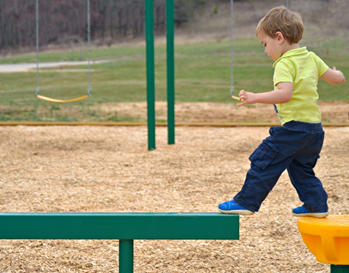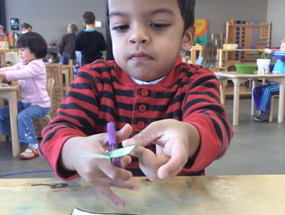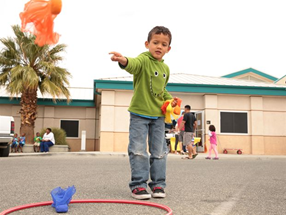13.5: Supporting Fundamental Movement Skills
Fundamental movement skills are the foundations on which more complex movement skills are built. Early childhood is a crucial and unique time for developing coordination of the basic movement skills. During this period, daily movement experiences significantly influence children’s patterns of movement and their future as happy, active movers. Children who develop these fundamental movement skills tend to become confident movers and have the building blocks for an active way of life.
Fundamental movement skills emerge following a developmental sequence from simple to more complex body actions. Initially, when children attempt a movement pattern, they move few body parts (e.g., when throwing, move only one arm while the rest of their body remains still). As their movement skills develop, children begin incorporating other body parts (e.g., throwing with one arm while stepping with one foot). Research-based developmental sequences represent common pathways of development and can guide instruction and learning. However, each child’s development is unique and affected by many factors (e.g., genetics, culture, special needs, socioeconomic status, environment, and practice). Teachers should expect variations in individual development.
Fundamental movement skills develop through meaningful interactions with the environment, people, and objects; through both structured (e.g., teacher-guided) and unstructured (e.g., child-initiated play) practice of movement skills; through the integration of fundamental motor skills into the preschool curriculum; and through the integration of fundamental movement skills into the daily home life of children. Children’s movement activities should be designed with consideration of the multiple cultures and diversity of the participants. In addition, teachers need to be sensitive to children with disabilities and special needs and modify the tasks, context, or environment, including appropriate assistive devices and instructional strategies, to facilitate the development of fundamental skills for all children.
Fundamental movement skills include:
Balance

The ability to balance is fundamental to all body movements. All movement involves elements of balance, and each movement has different balance requirements.
1.0 Balance
| At around 48 months of age | At around 60 months of age |
| 1.1 Maintain balance while holding still; sometimes may need assistance. | 1.1 Show increasing balance and control when holding still. |
| 1.2 Maintain balance while in motion when moving from one position to another or when changing directions, though balance may not be completely stable. | 1.2 Show increasing balance control while moving in different directions and when transitioning from one movement or position to another. |
Teachers can support children’s developing balance with the following:
- Design spaces and activities to develop balance following a developmental progression.
- Incorporate balance activities into the children’s world (such as acting out balancing challenges).
- Provide opportunities for activities that include both active movements and still body positions.
- Post pictures of balance positions and balance activities (can be of culturally representative athletes, dancers, performers, including those with disabilities).
- Design the environment so children combine balance skills with fundamental movement skills and movement concepts.
- Use visual aids, foot and handprints, and objects on the floor to promote balancing skills.
Locomotor Skills
The movement skills that children use to move effectively and efficiently through space. These skills allow children to travel, explore, and discover their environments. Preschool children use locomotor skills in their daily activities to move from one area to another.

2.0 Locomotor Skills
| At around 48 months of age | At around 60 months of age |
| 2.1 Walk with balance, not always stable, oppositional arm movements still developing, and relatively wide base of support (space between feet). | 2.1 Walk with balance, oppositional arm movements, and relatively narrow base of support (space between feet). |
| 2.2 Run with short stride length and feet off the ground for a short period of time. May show inconsistent opposition of arms and legs. | 2.2 Run with a longer stride length and each foot off the ground for a greater length of time. Opposition of arms and legs is more consistent. |
| 2.3 Jump for height (up or down) and for distance with beginning competence. | 2.3 Jump for height (up or down) and for distance with increasing competence. Uses arm swing to aid forward jump. |
| 2.4 Begin to demonstrate a variety of locomotor skills, such as galloping, sliding, hopping, and leaping. | 2.4 Demonstrate increasing ability and body coordination in a variety of locomotor skills, such as galloping, sliding, hopping, and leaping |
Teachers can support children’s developing locomotor skills with the following:
- Observe and analyze children’s locomotor skills to facilitate planning for learning opportunities.
- Promote progressive development of leg strength.
- Promote and be aware of the progressive development of coordination of locomotor skills.
- Encourage practice of locomotor movements in both indoor and outdoor environments.
- Use vivid visual information and visual aids that communicate to children in simple ways how to move.
- Use music, songs, rhymes, and stories to provide rhythmic patterns.
- Plan meaningful, purposeful, and connected locomotor activities and games.
- Create picture cards representing different ways to move related to children’s cultural background.
- Allow children to take risks in their physical play.
Manipulative Skills
Skills that allow children to use their arms, hands, legs, and feet to project an object away from the body (e.g., throwing a beanbag) or to receive and absorb the force of an object coming to the body (e.g., catching a balloon). Fundamental motor skills that involve large muscle groups are called gross motor skills (e.g., kicking) and the ones that involve small muscle groups are called fine motor skills (e.g., cutting).
 |
 |
Fine motor manipulative skills are usually those in which children manipulate objects with their hands. Fine motor manipulative skills include cutting, painting, and buttoning.
Gross motor manipulative skills include tossing, rolling, throwing, catching, striking, kicking, bouncing, and punting with objects.
3.0 Manipulative Skills
| At around 48 months of age | At around 60 months of age |
| 3.1 Begin to show gross motor manipulative skills by using arms, hands, and feet, such as rolling a ball underhand, tossing underhand, bouncing, catching, striking, throwing overhand, and kicking. | 3.1 Show gross motor manipulative skills by using arms, hands, and feet with increased coordination, such as rolling a ball underhand, tossing underhand, bouncing, catching, striking, throwing overhand, and kicking. |
| 3.2 Begin to show fine motor manipulative skills using hands and arms such as in-hand manipulation, writing, cutting, and dressing. | 3.2 Show increasing fine motor manipulative skills using hands and arms such as in-hand manipulation, writing, cutting, and dressing. |
You can find example representations of the developmental sequences of manipulative skills in Appendix D.
Teachers can support developing manipulative skills with the following:
- Observe developmental sequences of fundamental manipulative skills.
- Vary the focus of the manipulative skills (provide opportunities for both arms and legs to move).
- Provide a variety of equipment to accommodate individual differences in body size, skill level, and the development of children’s physical and sensory systems.
- Create manipulative activities that provide automatic feedback and a sense of accomplishment.[5]
Vignette
Children constructed birds and balls out of paper while playing indoors. They colored the papers using markers of different colors. Children also decorated their creations with colorful feathers and cut out shapes from magazines. They attached these decorations to their birds and balls with glue. When the decorations were dry, the teacher invited them to play with their birds and balls outside. The teacher, Ms. Gupta, previously had designed the outdoor play area by placing some colorful plastic hoops, cones, and shapes on the floor with pictures of the community buildings attached to them. She also drew a line two steps away from the pretend buildings.
Outside, she said to the children, “Let’s make the birds fly toward those buildings and see where they land.” The children became excited and began using the throwing action to fly their birds. Some children were much closer to the line, and others stood farther away. While throwing, they began adjusting their proximity to the line. Ms. Gupta said, “How can you move your bodies to make your bird fly up in the sky?” Jamila said, “I know, throw like this [moving her arm up and down].” Lesley said, “We need to step and send the bird up.” Ms. Gupta paused and observed them throwing for a while. One child’s bird was going down fast, and she said, “Xuyen, do you want your bird to go up?” Xuyen replied, “Yes.” Ms. Gupta asked, “How can we do that?” Xuyen shrugged her shoulders as though to say, “I do not know.”
Ms. Gupta then suggested, “How about if you throw it toward the sky?” Xuyen moved her arm up over her head in the throwing action, and her bird flew a little longer. She noticed and smiled, then ran to get it and tried again. Ms. Gupta smiled and said, “You moved your arm up this time. That is the way to make your bird go up: keep moving your arm up each time.” Another child was picking up his bird, and Ms. Gupta said, “Yeng, on what building did your bird land?” Yeng said, “The store.” and kept running back to try again. Ms. Gupta said to another child, “Mary, did your bird land in the hospital?” Mary replied, “No, that is the park.” Mary was right. Ms. Gupta continued asking different children about the buildings.[6]

